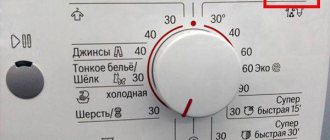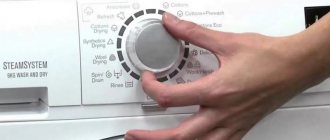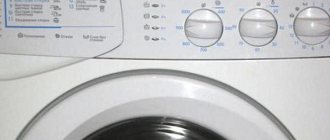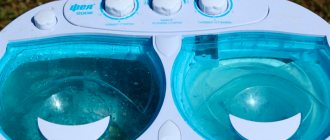How long does it take for an Indesit washing machine to wash?
Indesit program table: description and designations
| Name | Designation | The approximate time* |
| Jeans | You will see a picture of jeans on the panel. | |
| Express 15 | Duration: 15 minutes. | |
| Sport shoes | The panel shows sneakers. | Cycle time – 50 minutes. |
| Sport | Image of a soiled T-shirt. | Wash for 1 hour 18 minutes. |
Interesting materials:
How to paint an old pen? How to plan the inside of a wardrobe? How to arrange furniture in the living room? How to arrange furniture in a one-room Khrushchev building? How to arrange furniture in a rectangular room? How to position the desktop? How to recognize the quality of honey? How to recognize music by sound? How to straighten the fur on the hood? How to straighten polyester in a jacket?
What determines the duration of washing?
So, what can cause your washing time to increase (or decrease if you skip these steps):
- water temperature - the hotter it is, the longer it takes to heat it. Washing in cold water (30 degrees or less) is at least 10-15 minutes faster than in boiling water (80-90 degrees),
- turning on the pre-wash or additional wash mode. This will add a quarter of an hour to the main mode,
- modern machines even allow you to soak laundry, but this is also extra time (at least 1/3 of an hour),
- additional rinsing adds up to half an hour to the main washing time,
- spin mode. At high speeds (1000) it takes an average of 15 minutes to dry clothes, at lower speeds - faster - within 10 minutes,
- boiling laundry also takes extra time, at least to heat the water to the required temperature,
- use of intelligent modes. Modern machines are able to vary programs depending on the weight of the laundry and the degree of soiling. The larger the load, the longer the device will work. It’s the same with stains: the stronger they are, the more of them, the longer the wash will be,
- model and age of the machine. Modern devices are faster and more economical. With older machines, even a quick wash can take 40 minutes.
What does a full cycle consist of?
The sequential execution of the usual stages - washing, rinsing and wringing out things - constitutes a full cycle of operation of the machine. The device allows you to regulate the specifics of these operations.
Wash
The choice of washing mode is determined by the following parameters:
- fabric structure;
- the presence of decorative elements on products;
- contamination (you can include soaking, boiling cotton fabrics).
The right choice will determine not only how well things are washed, but also possible damage to the laundry from the aggressive effects of temperature and high speeds.
Rinsing
When rinsing, detergents are washed out of fabrics. Many people prefer to run an additional rinse mode to thoroughly wash the laundry from powder.
Wool shrinkage
All of the above recommendations help maintain the original appearance of the product. But sometimes you need to wash an item - for example, a wool sweater - so that it shrinks. For this, the following technology is used:
- Dip the sweater in soapy water heated to 50-60 degrees for 10 minutes.
- Wash it as usual.
- Rinse in cool water (15-20 degrees).
It is important not to allow too sudden temperature changes, otherwise the shrinkage will exceed all expectations. A woolen jacket can shrink by 3-4 sizes and turn from excessively large to small
In addition, you should remember to be careful when spinning and drying. In hot water, the pile fluffs up and becomes especially easily deformed.
Woolen items require careful handling and additional energy consumption for washing. But they reliably retain the body heat of their owner and look beautiful. Therefore, it is worth trying to remember simple rules for caring for hair. It's not difficult - there are only 5 most important points!
What can be washed in the cotton cycle?
First on the list is the “Cotton” mode - this is a basic program for soiled cotton and linen clothes. This washing mode with temperatures up to 60 °C is suitable for dyed fabrics, but if the temperature is higher, then you can only wash white items or dyed fabrics, but with very resistant paint.
Interesting materials:
How much alcohol is needed to keep water from freezing? How much water does it take to run a bath? How much water do you need for 450 g of pasta? How much water do you need for pea puree? How much water is needed to irrigate 1 hectare of alfalfa? How much water do you need per 1 kg of weight? How much water do you need for 1 tablespoon of gelatin? How much water do you need for 400 grams of sushi rice? How much water is needed for 800 grams of rice for pilaf? How much water do you need for half a kilo of buckwheat?
Spin time on an LG machine
Modern LG washing machines have similar operating algorithms. The owner of this brand of equipment can independently determine how much time the machine will spend spinning. To do this you need to do the following:
- Turn on the device.
- Using the button or selector, select the “Spin” function. The default speed is 1000 rpm. The display shows the spin time - 15 minutes.
Important! If you turn on the spin program at 1000 rpm and load wet laundry into the drum, it will spin for 15 minutes. In this case, at maximum speed the unit will operate for about 7 minutes, since it will take time to spin and stop the drum.
- If you select a spin speed of 800 rpm on the control panel, the display will show the time of 10 minutes. This is exactly how long this mode of operation will last in total.
- When choosing a speed of 400 revolutions, the LG washing machine spins for 7 minutes.
In some cases, it is necessary to use the “No spin” mode. In this case, the equipment simply drains the water from the drum. It takes her 1 minute to do this.
What temperature to choose for washing different types of fabric
When choosing a washing temperature, it is best to follow the information on the product label. However, if this is not possible, you can follow the general rules.
- items made of natural wool (both 100% and with the addition of cotton or synthetics) are washed at a minimum temperature of 20-30 degrees;
- clothes and linen made of silk and items with lace trim also require special delicacy; the recommended water temperature for washing is 30°C;
- items made of viscose silk require the same careful handling as natural silk; the water temperature for washing should not exceed 30°C;
- tulle curtains are washed at 30-40 degrees;
- lavsan, lycra, nylon and nylon are less demanding on temperature - the fibers can withstand temperatures up to 50-60°C, and chemical bleaches cannot be used for washing them. These restrictions also apply to items made from natural fibers with the addition of synthetics - even if the content of, for example, lavsan is 5%, if the permissible temperature is exceeded, the item may become deformed;
- fabrics made from 100% cotton, linen or jute can be washed at any temperature, however, it is not recommended to expose brightly colored fabric to very hot water - if systematically washed at temperatures above 60°C, even the most durable color will quickly fade;
- sportswear (fleece, thermal underwear, clothes made from membrane fabrics) are washed as carefully as possible, at a temperature of 30°C and using special products;
- jeans are washed at 30-40 degrees, this avoids deformation of the product and preserves the color of the fabric;
- Down jackets and clothes lined with synthetic padding are also washed at low temperatures - from 30 to 40 degrees.
Overview of washing modes
Modern devices have a more or less stable set of programs; they are built according to certain principles. Of course, individual parameters can be changed manually, but knowing the general parameters will also help you at least roughly figure out how long it will take to wash household appliances.
- Quick wash. It can be called something else (express, mini, daily, linen refreshment, etc.). This is a minimum duration program. Typically the duration ranges from 15 to 30 minutes. During this time, the laundry is slightly rinsed and refreshed. Suitable for regular washing of unworn items.
- Shoes. Modern household appliances allow you to wash even shoes. On average, it takes her from 30 to 50 minutes to deal with dirt.
- Delicate and hand wash. Used for washing delicate fabrics. The average washing time is from 40 to 60 minutes. The mode provides a lower temperature and fewer drum revolutions during spinning.
- Washing wool and silk also usually takes no more than an hour.
- Synthetics. In this mode, the machine operates for 1.5 hours.
- A special mode is used for washing large items. It is usually called "Blanket" or "Down" and lasts around 1 hour 30 minutes.
- Sport. Used for washing sports items. Essentially the same synthetics, only with an additional rinse, so it takes 15 minutes longer.
- Cotton or cotton/linen. Programs for washing natural fabrics are some of the longest, as they involve heating water to 90 degrees and thoroughly washing things. Typically the program lasts about 2 hours. There are accelerated modifications (“cotton fast”, etc.): in these cases, the laundry is washed at 60 or 40 degrees. It takes approximately 1.5 hours to complete all stages.
- Eco (bio, eco-care, etc.) is practically synonymous with the previous program, but an additional rinse is added,
- 2 - 2.5 hours are allotted for washing children's underwear, since they are supposed to be pre-washed, boiled and additionally rinsed,
- Intensive wash is used for heavily soiled items. In this mode, the machine can show everything it is capable of. Each manufacturer has its own set, but the maximum looks something like this: soak, pre-wash, boil, wash, rinse, spin, repeat cycle, additional rinse. Therefore, this mode takes a minimum of 2.5 hours, a maximum of 4 hours.
So, how long a washing machine washes depends on many factors, so it is difficult to say exactly how long the cycle will take. Almost every housewife today has a household washing machine. But washing is not effective every time. In order to buy a high-quality washing machine, you need to know what washing classes there are and, Why the door in the washing machine does not open after washing. Serious breakdowns and natural causes. A washing machine is a household appliance without which it is difficult to keep clothes clean. Most
What are the dangers of delicate washing?
“Doesn’t the sensitive program have any drawbacks?” - you ask with disbelief and you will be right. Like any phenomenon, gentle washing has a number of disadvantages that you need to be aware of.
The first and very significant (what a pun!) drawback is the proliferation of bacteria. Washing in a delicate program occurs at low temperatures - 30-40 degrees. This means that bacteria and microbes that have settled on clothing do not die. Not only that: they also manage to multiply and jump from washed linen to towels, dishes, and our hands. In the United States, a special study was conducted on this matter. His results showed: on underwear washed in a delicate cycle, feces were found - 0.1 grams on each item. And this is a breeding ground for bacteria. And it is useless to fight them solely by sorting clothes by color and/or fabric - you can defeat microbes only with the help of high temperatures, the researchers conclude.
If possible, try not to wash at least children's clothes at low degrees. As for “adult” products, pre-soak them in a soap solution, and thoroughly soap stains on clothes with laundry soap.
In addition to bacteria, powder also remains on clothes washed on the delicate cycle - which is why it is better to use liquid products. Dust mites, a source of allergic reactions, also “linger” on bed linen. They die exclusively in boiling water. The best thing you can do in this situation is not to buy bed linen made of silk and other “delicate” fabrics. It would be correct to purchase a bed made from materials that can withstand temperatures of 90-95 degrees.
It has long been known: “Forewarned is forearmed.” Use our recommendations, and no difficulties in this matter will affect you!
Consequences of non-compliance with washing frequency
Today, when every home has an automatic washing machine, many people resort to washing after every appearance. A reasonable question arises: is this justified?
The clear answer is no. Each item has its own washing frequency . Failure to comply with these deadlines may lead to negative consequences.
For example, too frequent washing will cause the fabric from which it is made to quickly become unusable and the colors will fade.
If you do not comply with the time limits for washing linen, kitchen and bath towels, microbes will begin to multiply on them, which will negatively affect your health .
The countdown of the delay time begins immediately after it is set.
The delay time starts counting immediately
same after its installation. This can be determined by the flashing dot between the number
and H". The dot flashes until
the set time will not expire.
GL Countdown of program start delay time
After the expiration of the specified period, the program
During the execution of one or another stage of the program, the corresponding indicator lights up.
bulb. The display shows
duration of the program (“Ready in”).
GL Changing the start delay time
programs can be executed at any moment. To do this, press the “31ag1 in” key until the value you need appears on the display
The newly set time is immediately
starts counting down. In repeated
there is no need to start the program.
Ш If another program is selected, then
previously set time “31ag1 in”
is cancelled. The time will appear on the display
“Weabu in” for the newly selected program. The time "31ag1 in" for the new program must
Source
How to reduce washing time?
- As mentioned above, washing time significantly depends on the heating temperature of the water, so set the maximum temperature only in exceptional cases. For cotton, linen and similar fabrics, 60°C is quite enough.
- For the “quick” washing mode, do not set the temperature above 40°C, since heating the water is absolutely pointless - the program is too short, and you will spend extra time and money on electricity.
- If you know at what temperature a particular item should be washed, at what speed it should be wrung out, and whether pre-soaking is necessary, then you can easily adjust the necessary washing parameters on the same “Cotton” mode, and the time will be optimal. After all, most modes are just variations to lure the buyer.
- Try using a delayed start - it is not necessary to let the machine wash when you are at home. The main thing is to be there when the laundry is washed so that it can be hung to dry. For example, you can set a timer in the evening so that you can take out the laundry when you wake up. Or vice versa, set the timer in the morning so that the machine finishes washing when you come home from work.
- One of the cases of increasing washing time can be called “overwashing”. In order not to waste time on re-washing, you need to choose the right operating mode - it’s better to wait an extra 20 minutes than to then re-wash for an hour and a half with the appropriate state of mind. As already mentioned, very often after the express mode, powder stains remain on things, so it’s better to immediately rinse again - you’ll save time and your nerves.
And a couple more tips. Before putting bulky and poorly wetted items into the drum of the washing machine, for example, a bologna jacket, down jacket, pillow, I would advise you to pre-wet them, especially if the washing machine is small. The fact is that such things, when dry, occupy the entire cavity of the drum, do not get wet, and the ribs of the drum do not mix them.
To save energy, try to load the machine as much as possible - you must agree, it will be more economical if the washing machine works three times a week, rather than daily. At the same time, you should not overload the washing machine, as the quality of washing will significantly decrease - the laundry should move freely in the drum.
To ensure that your laundry is always perfectly clean, use high-quality detergents - powders, gels, conditioners. Bad powder means not only unwashed items, but also the appearance of new stains that are removed by repeated rinsing. It is better to use liquid gel - pour it directly into the drum along with the laundry you are loading.











